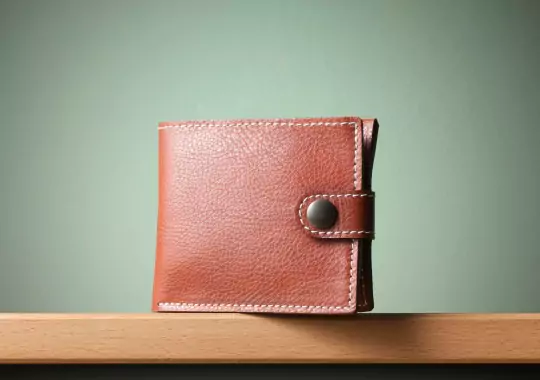In recent years, the smartphone has become a ubiquitous tool, seemingly capable of replacing everything from cameras to calendars. One area where it's been making strides is in replacing the traditional wallet. But are we truly at a point where we can ditch our wallets entirely and rely solely on our phones? Let's explore are wallets obsolete.
As Amazon affiliates we may earn a commission if you purchase a product at no cost to you.
The Smartphone Wallet Revolution
The smartphone has revolutionized many aspects of our lives, and one area where its impact is increasingly felt is in the realm of wallets. While it's clear that the smartphone is on its way to replacing the traditional wallet, it's also evident that we're not quite there yet.
One of the key indicators of this transition is the widespread acceptance of mobile payment methods like Apple Pay or Google Pay. Many establishments now offer these digital payment options, making it easier than ever to leave your physical wallet at home. However, despite this progress, not all businesses have embraced these technologies, meaning that in some situations, physical cash or cards are still necessary.
Another factor to consider is the need for physical cards in various aspects of our lives, such as health insurance or car insurance. While some services allow for digital cards, many still require physical copies. For example, here in California, a physical driver's license is still mandatory, despite the availability of digital driver's licenses in other states.
Furthermore, the transition to digital driver's licenses, which seems like a logical step in our increasingly digital world, has been slow to materialize. While some states have begun offering digital licenses, the rollout has been uneven, with many states still requiring physical licenses.
Overall, while the smartphone is well on its way to replacing the traditional wallet, there are still some hurdles to overcome. As technology continues to advance, however, it's likely that we'll see further integration of digital wallets into our everyday lives, eventually leading to a wallet-free future.
The Digitalization of Your Wallet
In addition to the convenience of mobile payments, the digitalization of your wallet offers a host of benefits that can enhance your everyday life. One of the most significant advantages is the ability to store items that were traditionally kept in physical wallets, such as photos or business cards, directly on your phone.
This digital storage not only streamlines your wallet but also offers added security. With password and biometric protection, you can rest assured that your sensitive information is safe and accessible only to you. Plus, the ability to access these items digitally means that you'll never have to worry about losing or misplacing them again.
Furthermore, the digitalization of your wallet opens up new possibilities for organization and customization. With digital storage, you can easily categorize and search through your items, making it easier than ever to find what you need when you need it. Additionally, you can customize your digital wallet to suit your needs, adding or removing items as necessary to keep your wallet clutter-free.
Overall, the digitalization of your wallet offers a convenient, secure, and customizable way to manage your essential items. As technology continues to advance, we can expect to see even more innovations in this area, making the transition to a digital wallet an increasingly attractive option for many people.

The Hybrid Solution: Wallet-Phone Cases
Personally, I made the switch to a hybrid wallet-phone case over a year ago, and it's been fantastic. This case allows me to store my essential cards and a bit of cash while keeping everything in one place. Sure, it makes my phone a bit bulkier, but I find the convenience far outweighs the slight inconvenience.
There are many wallet-phone case hybrid options available, so finding one that suits your needs shouldn't be difficult. I've included a link to the case I use in the description below, but any similar case should do the trick.
The Future of Wallets: Obsolete or Evolving?
As we look to the future, one question looms large: are traditional wallets on the brink of obsolescence, or are they simply evolving to meet the demands of the digital age? The answer, it seems, lies somewhere in between.
While wallets are not yet completely obsolete, they are certainly on the path to becoming so. The convenience and security offered by digital wallets are undeniable, making them an increasingly attractive option for many consumers. With the ability to store everything from credit cards to loyalty cards digitally on your phone, the need for a physical wallet is diminishing.
However, there are still some hurdles to overcome before wallets become a thing of the past. As mentioned earlier, not all establishments accept mobile payments, and some services still require physical cards. Additionally, there are concerns about the security of digital wallets, with some people worried about the potential for hacking or data breaches.
Despite these challenges, the trend towards digital wallets is clear. With continued advancements in technology, we may soon find ourselves living in a world where wallets are a thing of the past. In the meantime, hybrid solutions like wallet-phone cases offer a practical compromise, allowing us to enjoy the benefits of digital wallets while still having access to physical cards and cash when needed.
While wallets are not yet obsolete, they are certainly evolving. As technology continues to advance, we can expect to see further integration of digital wallets into our everyday lives, eventually leading to a future where wallets are a relic of the past.

Join the Conversation
The transition to digital wallets is a hot topic, and we want to hear from you. Are you ready to make the jump to a digital wallet, or are you sticking with your traditional wallet for now? Share your thoughts and experiences in the comments below.
For some, the convenience and security of digital wallets are irresistible, offering a streamlined way to manage finances and access essential cards and information. For others, the attachment to traditional wallets and concerns about security and compatibility with all establishments are holding them back.
Join the conversation and let us know where you stand. Do you see yourself going wallet-free in the future, or do you prefer the familiarity of a physical wallet? Your insights could help shape the future of wallets and digital payment methods.
Recommended Article

Frequently Asked Questions FAQs
Are wallets becoming obsolete with the rise of digital payment methods?
While digital payment methods are gaining popularity, wallets still serve a purpose. However, their usage may evolve as digital wallets offer convenience and security.
Are digital wallets secure enough to replace traditional wallets?
Digital wallets employ encryption, biometric authentication, and tokenization, making them secure. However, users should practice good security measures to protect their information.
Can I still use traditional wallets if I prefer physical cash and cards?
Absolutely! Traditional wallets are still relevant for those who prefer tangible forms of payment. However, digital wallets offer added convenience and features.
Conclusion
The shift towards digital wallets is more than just a trend; are wallets obsolete is a glimpse into the future of how we manage our finances and personal information. While traditional wallets still have their place, the convenience, security, and efficiency offered by digital wallets are undeniable.










